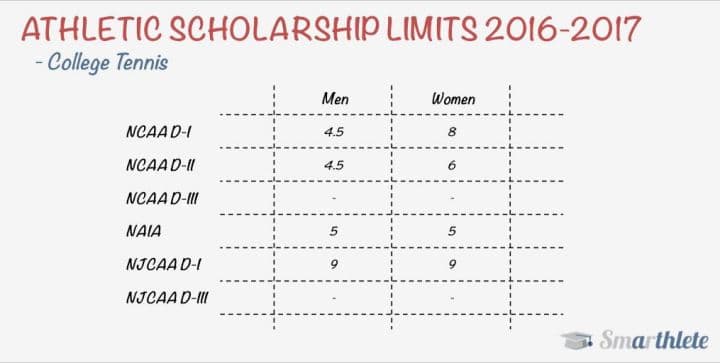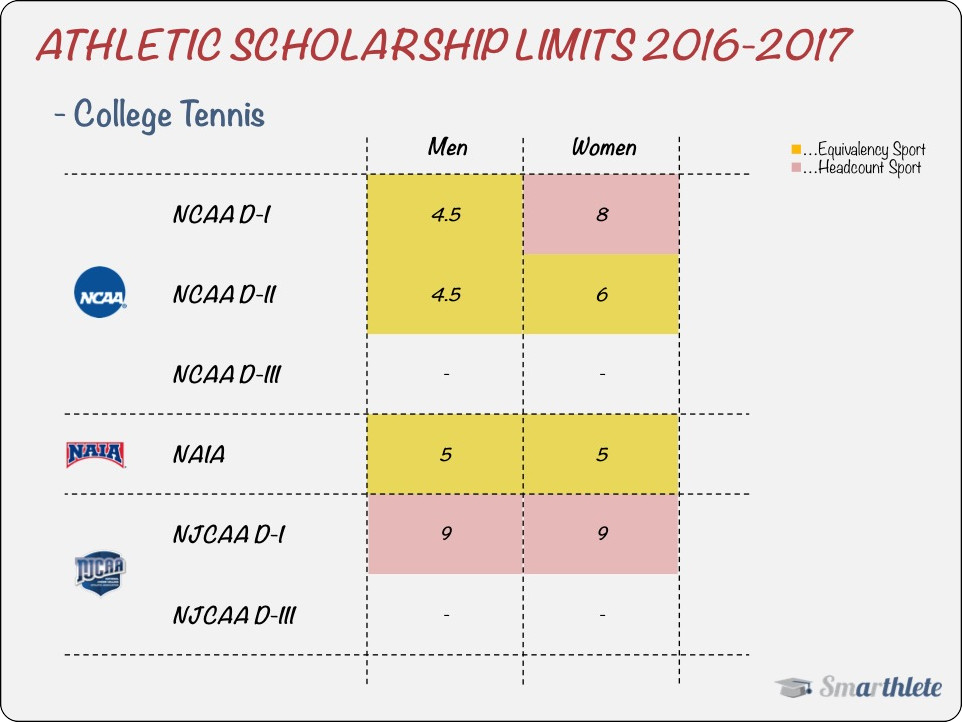Number of Scholarships in College Tennis

Say you're a tennis player, still in high school or the international equivalent of that, and you have decided that your education doesn't quite end with your graduation. Ideally, you have even identified an undergraduate degree that you'd be especially interested in.
Maybe your coach has told you that you should try to get an athletic scholarship to play college tennis. Perhaps your parents encourage you to look into this opportunity as paying for college is not cheap. Or perhaps, it's your friends who had been recruited and who keep telling you of the unbelievable time they have playing collegiate tennis. Either way, you want to learn more about it and one of the key questions is:
Tennis: Headcount Sport & Equivalency Sport
Before we outline the difference between "headcount" and "equivalency" sport, we need to touch upon the different governing associations of college sports (college tennis) and the various divisions.
Firstly, there's the NCAA, which consists of three divisions: Division 1 (D-I), Division 2 (D-II) and Division 3 (D-III). Apart from the NCAA, there are also the NAIA and the NJCAA.
College coaches of teams in NCAA, NAIA and NJCAA have athletic scholarship money for varsity sports, and thus college tennis, available.
How does this tie into headcount and equivalency sports? Headcount sport stands for the fact that recruits receive full-ride scholarships. There is only one division, in which that's the case: NCAA D-I women's tennis.
Equivalency sport in contrast means that coaches may award recruits with partial scholarships. Doesn't quite make sense yet? No worries, it will in a bit!
Scholarship Limits
The above-mentioned NCAA, NAIA, and NJCAA put limits in place as to how many scholarships each team can give away. Here's a graphic, which will give you an overview on the scholarship limits per team.

- Note, that D-I women's tennis is the only NCAA division, which is a headcount sport with a maximum of 8 scholarships per team.
- NCAA D-I and D-II men's tennis has a limit of 4.5 scholarships per team.
- NCAA D-II women's tennis has a limit of 6 scholarships per team.
- NAIA limits the scholarships to 5 per team.
- NJCAA D-I coaches may give away a maximum of 9 scholarships per team.*
- D-III coaches (NCAA and NJCAA) don't have athletic scholarship grants.
Value of Athletic Scholarships
What's the value of a scholarship and what does it cover? The scholarship covers a number of costs, although the definition differs somewhat between the various governing associations.
- According to NCAA regulations, a full scholarship covers "tuition and fees, room, board and course-related books".
- According to NAIA regulations, a full scholarship covers tuition, mandatory fees, books and supplies required for courses in which the student-athlete is enrolled, and room and board.
- According to NJCAA regulations, a full scholarship essentially covers the same in NJCAA Division 1* (+ one-time transportation to the college per academic year).
Scholarship Examples
Now let's put all the pieces together to give you a better feel for the dynamics of the scholarship search:
Example 1: Say you are a strong female player (Player A) with lots of coaches from NCAA D-I and top D-II schools interested in you.
- Coach A from a D-I school offers a full-ride scholarship to you. That means she would have another 7 full scholarships available for the remaining girls on the team.
- Coach B from a D-II school also offers a full-ride scholarship to you. Given that D-II tennis is an equivalency sport (maximum amount of scholarship is 6) a full scholarship for you reduces the remaining budget to the value of 5 scholarships. The coach could award the 5 scholarships to many players on the team. She could award Player B a scholarship, equivalent to 90% of a full scholarship. Player C, D could receive 80% each, and Player E gets 70%. That leaves the coach with another 1.8 scholarships, which she could choose to split among 3 players with 60% athletic scholarship each.
- Coach C from a NAIA team offers a partial scholarship to you, covering 75% of the total costs. The remaining 4.25 scholarships on the team can be split among several players by the coach as in the previous example!
That would leave you with a bill of 25% to be paid. If the equivalent of all the above costs is 40,000 USD per academic year, you would be left with 10,000 USD a year. If the school is cheaper and total costs per academic year amount to 20,000 USD, your share to be paid would be significantly lower: 5,000 USD.
Example 2: Say you're a mediocre male player with a tight budget and you believe NCAA D-I and D-II tennis is too far a shot for you?
- You have an offer from Coach A from a D-II school, but he is not able to offer more than 30% to you, as the rest of his scholarship money (equivalent to 4.2 scholarships) is already tied up with plenty of juniors, sophomore, and freshman on the team. As in the example above, you'd be left with paying 70% of the total costs.
- Coach B from a NAIA school in your state of residency makes an attractive offer, covering 70% of the costs. The cost per academic year is 20,000 USD, which makes the remaining 30% (5,000 USD) affordable for your family.
Given the maximum 5 scholarships per team, there are 4.3 scholarships left for the other players. - Finally, Coach C from a NJCAA (Division I) team also offers a full scholarship to you, but it would entail that you transfer after two years, as schools in the NJCAA are so-called junior colleges (= 2-year colleges).
Good to know about college tennis
Other things worth knowing are the following:
- Fewer grants per team
The stated scholarship limits are the maximum amounts permitted by the governing associations. An athletic department/team can also choose to award less scholarship money or no grants at all (e.g. Ivy League schools). - In-state, out-of state & international students
There is an important difference depending on where you come from. Schools' tuition fees differ for US students (whether they study at a college within their state of residency or in another state) and international students. The cheapest option is enrolment at college in the state of residency. - Duration of agreement
While scholarships are only awarded for one academic year, they are typically extended year after year and cover the full four years of the students' enrolment. Division 1 schools may provide multi-year scholarships to its student-athletes. - Scholarship availability
Keep in mind that a squad consists of several players; typically a good mix of freshmen, sophomore, juniors, or seniors. You'll never find a team that consists of 6 seniors at the same time. As a result, there is only so much scholarship money available for the upcoming semesters, depending on the composition of the team. Not a single senior on the team - chances are low the coach will be interested, as he won't have any athletic scholarship left. A team with 3 seniors? Lovely, there might be a nice amount of scholarship money available as the coach needs to replace his graduates!
Now that you're all informed on the way it works with the available financial aid, look no further. Smarthlete is a college tennis recruiting network, where you can sign up with a free recruiting profile, contact coaches, get discovered by coaches of all divisions, and find a scholarship to play collegiate tennis!
In case you still have doubts read up on Whether You Are Good Enough to Play College Tennis or get started right away with setting up your recruiting profile! If you have any questions, just send us an email (contact@smarthlete.com) and we'll get back to you! :)
*NJCAA D-I: Three of the nine scholarships given may be a maximum of tuition, fees, room, board, course related books, up to $250 in course required supplies and transportation costs to and from the college by direct route one time per academic year. Six of the nine scholarships are limited to tuition, fees, course related books and up to $250 in course required supplies.